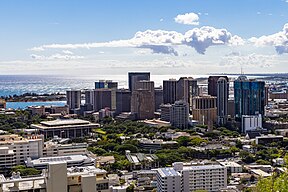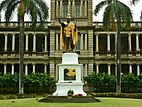Honolulu | |
|---|---|
| City and County of Honolulu | |
Waterfront on Waikiki Beach Statue of King Kamehameha I in front of Aliʻiōlani Hale downtown | |
|
| |
| Nicknames: Crossroads of the Pacific, Sheltered Bay, HNL, The Big Pineapple, Paradise | |
| Motto: Haʻaheo No ʻO Honolulu (The Pride of Honolulu)[1] | |
 Urban Honolulu and East Honolulu CDPs (combined) in Honolulu County and the state of Hawaii | |
Location in Hawaii (of the 2000 U.S. Census definition) | |
| Coordinates: 21°18′25″N 157°51′30″W / 21.30694°N 157.85833°W | |
| Country | United States |
| State | Hawaii |
| County | Honolulu |
| Incorporated | April 30, 1907[2] |
| Government | |
| • Mayor | Rick Blangiardi (I) |
| • Council | Members |
| Area | |
| • City | 68.4 sq mi (177.2 km2) |
| • Land | 60.5 sq mi (156.7 km2) |
| • Water | 7.9 sq mi (20.5 km2) |
| • Urban | 145.0 sq mi (375.5 km2) |
| Elevation | 16 ft (5 m) |
| Population | |
| • City | 350,964 (US: 56th) |
| • Density | 5,791/sq mi (2,236.1/km2) |
| • Urban | 853,252 (US: 54th) |
| • Urban density | 5,885/sq mi (2,272.4/km2) |
| • Metro | 1,016,508[5] (US: 56th) |
| Demonym | Honolulan |
| Time zone | UTC−10:00 (Hawaiian (HST)) |
| ZIP Codes | 96801–96826, 96828, 96830, 96836-96841, 96843-96844, 96846-96850 |
| Area code | 808 |
| FIPS code | 15-17000 |
| GNIS feature ID | 366212[4] |
| Website | www |
Honolulu (/ˌhɒnəˈluːluː/ HON-ə-LOO-loo;[7] Hawaiian: [honoˈlulu]) is the capital and most populous city of the U.S. state of Hawaii, located in the Pacific Ocean. It is the county seat of the consolidated City and County of Honolulu, situated along the southeast coast of the island of Oʻahu,[a] and is the westernmost and southernmost major U.S. city. Honolulu is Hawaii's main gateway to the world. It is also a major hub for business, finance, hospitality, and military defense in both the state and Oceania. The city is characterized by a mix of various Asian, Western, and Pacific cultures, reflected in its diverse demography, cuisine, and traditions.
Honolulu is Hawaiian for "sheltered harbor"[9] or "calm port";[10] its old name, Kou, roughly encompasses the area from Nuʻuanu Avenue to Alakea Street and from Hotel Street to Queen Street, which is the heart of the present downtown district.[11] The city's desirability as a port accounts for its historical growth and importance in the Hawaiian archipelago and the broader Pacific region. Honolulu has been the capital of the Hawaiian Islands since 1845, firstly of the independent Hawaiian Kingdom, and since 1898 of the U.S. territory and state of Hawaii. The city gained worldwide recognition following the Empire of Japan's attack on nearby Pearl Harbor on December 7, 1941, which prompted the entry of the U.S. into World War II; the harbor remains a major U.S. Navy base, hosting the United States Pacific Fleet, the world's largest naval command.[12]
The U.S. Census Bureau recognizes the approximate area commonly referred to as the "City of Honolulu" as the Urban Honolulu census-designated place. As of the 2020 U.S. Census, the population of Honolulu was 350,964. The Urban Honolulu Metropolitan Statistical Area had 1,016,508 residents in 2020.[5] With over 300,000 residents, Honolulu is the most populous Oceanian city outside Australasia.[13][14]
Honolulu's favorable tropical climate, rich natural scenery, and extensive beaches make it a popular global destination for tourists. With over 711,000 visitors as of 2022, Honolulu is the tenth-most visited city in the United States after New York City, Miami, Orlando, Los Angeles, San Francisco, Las Vegas, Washington, D.C., Chicago, and Boston.[15]
- ^ Honolulu And Kapolei Share City Lights 2005, Honolulu, HI, US: Honolulu County, Hawaii, November 29, 2005, archived from the original on November 5, 2013, retrieved June 30, 2012
- ^ "About the City, Official Website of the City and County of Honolulu". City and County of Honolulu. April 24, 2012. Archived from the original on October 12, 2004. Retrieved April 24, 2012.
- ^ "Geographic Ientifiers: 2010 Demographic Profile Data (G001): Urban Honolulu CDP, Hawaii". United States Census Bureau. Retrieved May 25, 2012.
- ^ a b "Honolulu". Geographic Names Information System. United States Geological Survey, United States Department of the Interior. Retrieved December 29, 2013.
- ^ a b "2020 Population and Housing State Data". United States Census Bureau, Population Division. August 12, 2021. Retrieved August 14, 2021.
- ^ "Urban Honolulu, Hawaii". U.S. Census Bureau. Retrieved December 4, 2022.
- ^ Dictionary Reference
- ^ US Census Bureau – Population Division. "Places Cartographic Boundary Files Descriptions and Metadata". Washington, D.C., US: U.S. Census Bureau. Archived from the original on July 10, 2012. Retrieved July 14, 2012.
Hawaii is the only state that has no incorporated places recognized by the U.S. Census Bureau. All places shown in the data products for Hawaii are CDPs. By agreement with the state of Hawaii, the U.S. Census Bureau does not show data separately for the city of Honolulu, which is coextensive with Honolulu County.
- ^ "About the City". Honolulu.gov. Archived from the original on February 1, 2015. Retrieved October 21, 2014.
- ^ "etymonline.com entry for Honolulu". Retrieved August 27, 2013.
- ^ "This Is Your City and County of Honolulu Government". honolulu.gov. Archived from the original on October 12, 2004. Retrieved May 22, 2012.
- ^ "Commander, U.S. Pacific Fleet". www.cpf.navy.mil. Retrieved December 14, 2020.
- ^ Ash, Russell (1998). The top 10 of everything. p. 100.
- ^ Long-Range Futures Research: An Application of Complexity Science, Robert Samet, 2009, 272
- ^ "America's 10 most visited cities", World Atlas, April 5, 2024
Cite error: There are <ref group=lower-alpha> tags or {{efn}} templates on this page, but the references will not show without a {{reflist|group=lower-alpha}} template or {{notelist}} template (see the help page).








